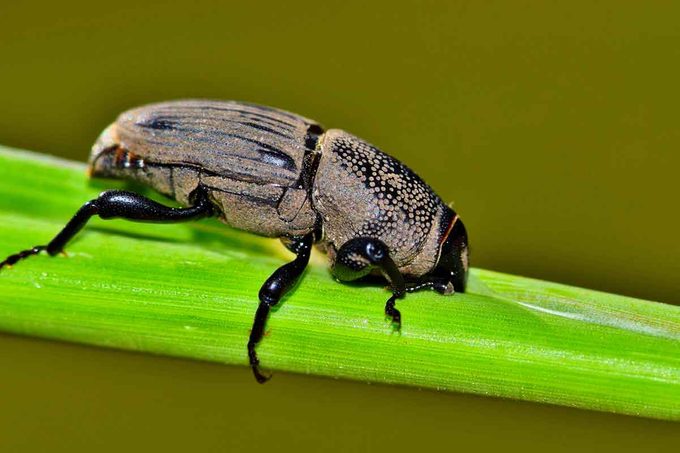Lawn Grubs: How Do I Get Rid of Them? | The Family Handyman
Every editorial product is independently selected, though we may be compensated or receive an affiliate commission if yous purchase something through our links. Ratings and prices are accurate and items are in stock as of time of publication.
A few grub worms are no trouble. A lot of grubs spell problem for your yard. Acquire how to spot, care for and forestall a lawn grub infestation.
If you take a turf lawn, y'all nigh certainly have lawn grubs. These destructive pests are nowadays during certain times of the yr in about parts of the U.S.
Your good for you grass tin sustain a little lawn grub damage and be OK. But when grubs proliferate, they can actually wreak havoc. Take action before it's also late. Read on to learn what yous need to about backyard grubs, including how to preclude and eradicate them.
What Are Lawn Grubs?
Backyard grubs, or grub worms, are the white, c-shaped larvae of several types of beetles. They have brown heads and six legs at the forepart of their trunk. They range from a quarter-inch to two inches long and feed on the grass roots.
Past the larval phase, chow worms will course cocoons, or pupae, and sally as billbugs or scarab beetles. They lie low for the winter. Past springtime they're ready to lay eggs, which become grubs, and the bike continues.
Types of Backyard Grubs
Lawn grubs are billbug or scarab beetle larvae. Among billbugs, the most mutual types that infest lawns in the U.S. are:
- Hunting billbug, Sphenophorus venatus vestitus Chittenden;
- Bluegrass billbug, Sphenophorus parvulus Gyllenhal;
- Denver billbug, Sphenophorus cicatristriatus;
- Bottom billbug Sphenophorus minimus Hart;
- Unequal billbug Sphenophorus inaequalis.

There are 1,300 types of scarab beetles in the U.South., but non all of them are out to eat your backyard. The most common scarab beetles that assail American lawns are:
- Japanese beetle, Popillia japonica (an invasive);
- June beetle, Phyllophaga (includes dozens of species likewise called green June beetle, June problems or May protrude);
- Masked chafer, Cyclocephala borealis;
- Argentinian scarab, Cyclocephala signaticollis (invasive);
- African black protrude, Heteronychus arator (invasive);
- European chafer, Amphimallon majale (invasive).
How Grubs Impact the Lawn
Valerie Smith of Sod Solutions, which provides turfgrass for commercial and residential lawns, says, "Given the right opportunity and the appropriate corporeality of fourth dimension, grub worms take the capability to completely destroy an entire lawn."
Lawn grubs live hugger-mugger and feed on the roots and thatch of grass. Grubs are typically dormant in the winter months, and practise the most feeding — and damage — in spring and late summer. They especially thrive in southern climates, where at that place is no wintertime freeze to kill them off.
Left unchecked, a lawn grub infestation can weaken and impale sections of grass where the root organization has been destroyed and the turf can no longer absorb h2o.
Signs of Lawn Grubs
According to the pros at Sod Solutions, here are some telltale signs of backyard grub bug:
- An increment in crows, raccoons and earthworks pests, like moles, in your lawn. They're at that place to feed on the grubs.
- Weeds first to pop up due to weakened turf.
- Dying or damaged areas of grass.
- Spongey-feeling grass.
- Grass lifts up like a piece of rug because its roots have died off.
Of class, some other sure way to tell if y'all have grubs is to really run across them in your soil. Dig downward iii to four inches in several different sections of soil. An occasional grub is not crusade for concern. But if you lot detect more than v grub worms per square foot, Sod Solutions says it's time for firsthand handling.
How to Go Rid of Backyard Grubs
In nigh climates, grubs are almost the surface of the soil. They're at their smallest and most vulnerable in August and September, and then these are the best months to care for for them.
Sod Solutions recommends Dylox 6.ii Granular White Grub Insecticide, which needs to be applied with a broadcast spreader and watered within 24 hours. Notwithstanding, this product is toxic to wildlife, and shouldn't enter storm drains or drainage ditches. For a natural pest solution, try one or more than of these options:
- Introduce nematodes — beneficial, microscopic worms that feed on chow worms.
- Innovate milky spore, a naturally occurring "illness" that attacks grub worms but doesn't damage other plants or wildlife. The spores must be spread several times over ii years, but they protect your lawn for 10 years or more.
- Create a bird-friendly habitat by placing birdhouses and birdbaths in your thou to attract insect-eating birds similar robins, wrens and jays. They'll eat the grubs, along with the beetles once they kickoff to emerge.
How to Prevent Lawn Grubs From Coming Back
A healthy lawn is the all-time defence against chow worms and beetles. Fertilize your backyard once or twice a yr and remove built-up thatch. You may want to consider an organic lawn fertilizer, especially if y'all've introduced beneficial nematodes. Some chemical fertilizers will kill nematodes.
Should You Call a Professional?
If you already employ a lawn service to proceed your chiliad smashing and good for you, they will probable spot your grub problem and propose treatments. If not, you can phone call a lawn service to treat the lawn. But grub eradication is a doable DIY project. Pros are probably going to apply the same methods you would if y'all treated the lawn yourself, and so the but advantage of hiring a pro is to save yourself the hassle.
Source: https://www.familyhandyman.com/article/lawn-grubs/
0 Response to "Lawn Grubs: How Do I Get Rid of Them? | The Family Handyman"
ارسال یک نظر